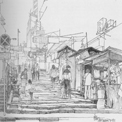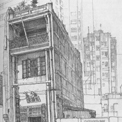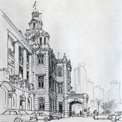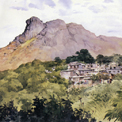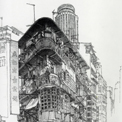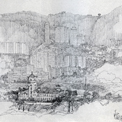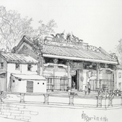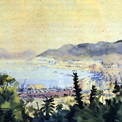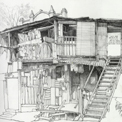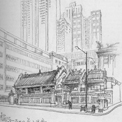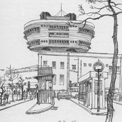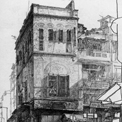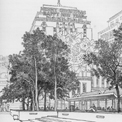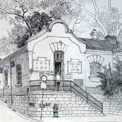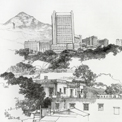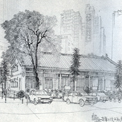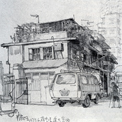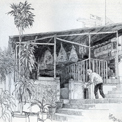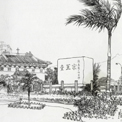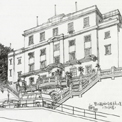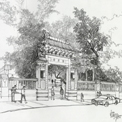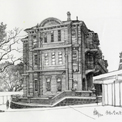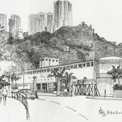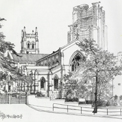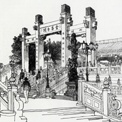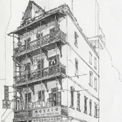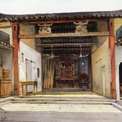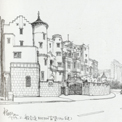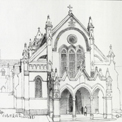The Old Pawnshop at Hollywood Road
Pawnbroking existed in Hong Kong long before it became a colony. It came into existence in the Tang Dynasty (618-907) and was very popular in the Sung Dynasty (906-1279). In the past, pawnbrokers were only found in market towns, mostly in Yuen Long. Pu Yuan Pawnshop in Yuen Long Old Market has had a history of 200 years. In the early days, the people of Hong Kong were mostly labourers. They spent their leisure time gambling and often had to pawn valuables to get cash. The trade flourished and many pawnbrokers moved in. A pawnbroker was popularly known as "second great uncle". Pawnbrokers at that time had to pay a license fee and ordinary taxes like other traders. But they found it difficult to avoid taking in stolen goods. In 1858, the owner of the Fu Hui Pawnshop was sentenced to fourteen years' banishment (banishment was abolished in 1911) for handling a stolen pocket watch. The Chinese saw this as racial prejudice and organized a signature campaign. Under this pressure, the governor at that time, Sir John Bowring, changed the sentence to two years' imprisonment. In 1853, pawnbrokers went on strike for the first time in protest against harassment by the police. In 1858, they went on strike again when they thought the license fee was too high. The "King of Pawnbroking", Li Yau Chuen , was honoured in 1929 for his contribution to the trade. In that year, he had an 80% share of all pawnshops in Hong Kong. The trade thrived during the Japanese occupation when it was the only trade with good business. In the 1970s, credit companies emerged and banks were set up one after another. Land prices and rent were also high. Pawnbroking gradually declined even though pawnbrokers changed their manner of operation.
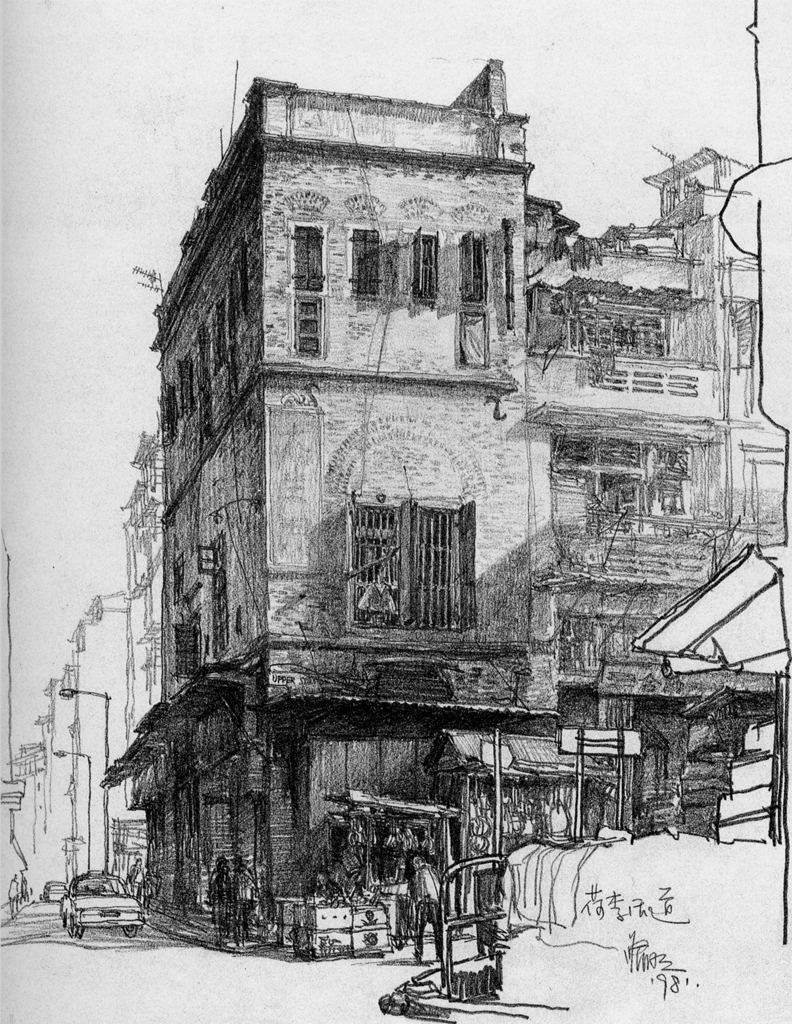
| Date | 1981 |
| Place | Hong Kong Island/Central and Western District/Sheung Wan/Hollywood Road |
| people | Kong Kai Ming |
| Material Type | Image |
| Collection | Sketches by Kong Kai-ming |
| Source | Kong, Kai Ming. A Collection of Paintings and Drawings by Kong Kai Ming. Historical Anecdots of Hong Kong: Hong Kong Island and Outlying Islands. (Hong Kong: Diakonic Consultant & Management Company Ltd., 1990), p.52 |
| Repository | The University of Hong Kong Libraries |
| Note to Copyright | Permission for use is given by Kong Kai Ming |
| Accession No. | LA005-048 |
The Old Pawnshop at Hollywood Road
Pawnbroking existed in Hong Kong long before it became a colony. It came into existence in the Tang Dynasty (618-907) and was very popular in the Sung Dynasty (906-1279). In the past, pawnbrokers were only found in market towns, mostly in Yuen Long. Pu Yuan Pawnshop in Yuen Long Old Market has had a history of 200 years. In the early days, the people of Hong Kong were mostly labourers. They spent their leisure time gambling and often had to pawn valuables to get cash. The trade flourished and many pawnbrokers moved in. A pawnbroker was popularly known as "second great uncle". Pawnbrokers at that time had to pay a license fee and ordinary taxes like other traders. But they found it difficult to avoid taking in stolen goods. In 1858, the owner of the Fu Hui Pawnshop was sentenced to fourteen years' banishment (banishment was abolished in 1911) for handling a stolen pocket watch. The Chinese saw this as racial prejudice and organized a signature campaign. Under this pressure, the governor at that time, Sir John Bowring, changed the sentence to two years' imprisonment. In 1853, pawnbrokers went on strike for the first time in protest against harassment by the police. In 1858, they went on strike again when they thought the license fee was too high. The "King of Pawnbroking", Li Yau Chuen , was honoured in 1929 for his contribution to the trade. In that year, he had an 80% share of all pawnshops in Hong Kong. The trade thrived during the Japanese occupation when it was the only trade with good business. In the 1970s, credit companies emerged and banks were set up one after another. Land prices and rent were also high. Pawnbroking gradually declined even though pawnbrokers changed their manner of operation.
| Date | 1981 |
| Place | Hong Kong Island/Central and Western District/Sheung Wan/Hollywood Road |
| People | Kong Kai Ming |
| Material Type | Image |
| Collection | Sketches by Kong Kai-ming |
| Source | Kong, Kai Ming. A Collection of Paintings and Drawings by Kong Kai Ming. Historical Anecdots of Hong Kong: Hong Kong Island and Outlying Islands. (Hong Kong: Diakonic Consultant & Management Company Ltd., 1990), p.52 |
| Repository | The University of Hong Kong Libraries |
| Note to Copyright | Permission for use is given by Kong Kai Ming |
| Accession No. | LA005-048 |
The Old Pawnshop at Hollywood Road
Pawnbroking existed in Hong Kong long before it became a colony. It came into existence in the Tang Dynasty (618-907) and was very popular in the Sung Dynasty (906-1279). In the past, pawnbrokers were only found in market towns, mostly in Yuen Long. Pu Yuan Pawnshop in Yuen Long Old Market has had a history of 200 years. In the early days, the people of Hong Kong were mostly labourers. They spent their leisure time gambling and often had to pawn valuables to get cash. The trade flourished and many pawnbrokers moved in. A pawnbroker was popularly known as "second great uncle". Pawnbrokers at that time had to pay a license fee and ordinary taxes like other traders. But they found it difficult to avoid taking in stolen goods. In 1858, the owner of the Fu Hui Pawnshop was sentenced to fourteen years' banishment (banishment was abolished in 1911) for handling a stolen pocket watch. The Chinese saw this as racial prejudice and organized a signature campaign. Under this pressure, the governor at that time, Sir John Bowring, changed the sentence to two years' imprisonment. In 1853, pawnbrokers went on strike for the first time in protest against harassment by the police. In 1858, they went on strike again when they thought the license fee was too high. The "King of Pawnbroking", Li Yau Chuen , was honoured in 1929 for his contribution to the trade. In that year, he had an 80% share of all pawnshops in Hong Kong. The trade thrived during the Japanese occupation when it was the only trade with good business. In the 1970s, credit companies emerged and banks were set up one after another. Land prices and rent were also high. Pawnbroking gradually declined even though pawnbrokers changed their manner of operation.
| Date | 1981 |
| Place | Hong Kong Island/Central and Western District/Sheung Wan/Hollywood Road |
| People | Kong Kai Ming |
| Material Type | Image |
| Collection | Sketches by Kong Kai-ming |
| Source | Kong, Kai Ming. A Collection of Paintings and Drawings by Kong Kai Ming. Historical Anecdots of Hong Kong: Hong Kong Island and Outlying Islands. (Hong Kong: Diakonic Consultant & Management Company Ltd., 1990), p.52 |
| Repository | The University of Hong Kong Libraries |
| Note to Copyright | Permission for use is given by Kong Kai Ming |
| Accession No. | LA005-048 |
The Old Pawnshop at Hollywood Road
Pawnbroking existed in Hong Kong long before it became a colony. It came into existence in the Tang Dynasty (618-907) and was very popular in the Sung Dynasty (906-1279). In the past, pawnbrokers were only found in market towns, mostly in Yuen Long. Pu Yuan Pawnshop in Yuen Long Old Market has had a history of 200 years. In the early days, the people of Hong Kong were mostly labourers. They spent their leisure time gambling and often had to pawn valuables to get cash. The trade flourished and many pawnbrokers moved in. A pawnbroker was popularly known as "second great uncle". Pawnbrokers at that time had to pay a license fee and ordinary taxes like other traders. But they found it difficult to avoid taking in stolen goods. In 1858, the owner of the Fu Hui Pawnshop was sentenced to fourteen years' banishment (banishment was abolished in 1911) for handling a stolen pocket watch. The Chinese saw this as racial prejudice and organized a signature campaign. Under this pressure, the governor at that time, Sir John Bowring, changed the sentence to two years' imprisonment. In 1853, pawnbrokers went on strike for the first time in protest against harassment by the police. In 1858, they went on strike again when they thought the license fee was too high. The "King of Pawnbroking", Li Yau Chuen , was honoured in 1929 for his contribution to the trade. In that year, he had an 80% share of all pawnshops in Hong Kong. The trade thrived during the Japanese occupation when it was the only trade with good business. In the 1970s, credit companies emerged and banks were set up one after another. Land prices and rent were also high. Pawnbroking gradually declined even though pawnbrokers changed their manner of operation.
| Date | 1981 |
| Place | Hong Kong Island/Central and Western District/Sheung Wan/Hollywood Road |
| People | Kong Kai Ming |
| Material Type | Image |
| Collection | Sketches by Kong Kai-ming |
| Source | Kong, Kai Ming. A Collection of Paintings and Drawings by Kong Kai Ming. Historical Anecdots of Hong Kong: Hong Kong Island and Outlying Islands. (Hong Kong: Diakonic Consultant & Management Company Ltd., 1990), p.52 |
| Repository | The University of Hong Kong Libraries |
| Note to Copyright | Permission for use is given by Kong Kai Ming |
| Accession No. | LA005-048 |
The Old Pawnshop at Hollywood Road
Pawnbroking existed in Hong Kong long before it became a colony. It came into existence in the Tang Dynasty (618-907) and was very popular in the Sung Dynasty (906-1279). In the past, pawnbrokers were only found in market towns, mostly in Yuen Long. Pu Yuan Pawnshop in Yuen Long Old Market has had a history of 200 years. In the early days, the people of Hong Kong were mostly labourers. They spent their leisure time gambling and often had to pawn valuables to get cash. The trade flourished and many pawnbrokers moved in. A pawnbroker was popularly known as "second great uncle". Pawnbrokers at that time had to pay a license fee and ordinary taxes like other traders. But they found it difficult to avoid taking in stolen goods. In 1858, the owner of the Fu Hui Pawnshop was sentenced to fourteen years' banishment (banishment was abolished in 1911) for handling a stolen pocket watch. The Chinese saw this as racial prejudice and organized a signature campaign. Under this pressure, the governor at that time, Sir John Bowring, changed the sentence to two years' imprisonment. In 1853, pawnbrokers went on strike for the first time in protest against harassment by the police. In 1858, they went on strike again when they thought the license fee was too high. The "King of Pawnbroking", Li Yau Chuen , was honoured in 1929 for his contribution to the trade. In that year, he had an 80% share of all pawnshops in Hong Kong. The trade thrived during the Japanese occupation when it was the only trade with good business. In the 1970s, credit companies emerged and banks were set up one after another. Land prices and rent were also high. Pawnbroking gradually declined even though pawnbrokers changed their manner of operation.
| Date | 1981 |
| People | Kong Kai Ming |
| Material Type | Image |
| Collection | Sketches by Kong Kai-ming |
| Source | Kong, Kai Ming. A Collection of Paintings and Drawings by Kong Kai Ming. Historical Anecdots of Hong Kong: Hong Kong Island and Outlying Islands. (Hong Kong: Diakonic Consultant & Management Company Ltd., 1990), p.52 |
| Repository | The University of Hong Kong Libraries |
| Note to Copyright | Permission for use is given by Kong Kai Ming |
| Accession No. | LA005-048 |
The Old Pawnshop at Hollywood Road
Pawnbroking existed in Hong Kong long before it became a colony. It came into existence in the Tang Dynasty (618-907) and was very popular in the Sung Dynasty (906-1279). In the past, pawnbrokers were only found in market towns, mostly in Yuen Long. Pu Yuan Pawnshop in Yuen Long Old Market has had a history of 200 years. In the early days, the people of Hong Kong were mostly labourers. They spent their leisure time gambling and often had to pawn valuables to get cash. The trade flourished and many pawnbrokers moved in. A pawnbroker was popularly known as "second great uncle". Pawnbrokers at that time had to pay a license fee and ordinary taxes like other traders. But they found it difficult to avoid taking in stolen goods. In 1858, the owner of the Fu Hui Pawnshop was sentenced to fourteen years' banishment (banishment was abolished in 1911) for handling a stolen pocket watch. The Chinese saw this as racial prejudice and organized a signature campaign. Under this pressure, the governor at that time, Sir John Bowring, changed the sentence to two years' imprisonment. In 1853, pawnbrokers went on strike for the first time in protest against harassment by the police. In 1858, they went on strike again when they thought the license fee was too high. The "King of Pawnbroking", Li Yau Chuen , was honoured in 1929 for his contribution to the trade. In that year, he had an 80% share of all pawnshops in Hong Kong. The trade thrived during the Japanese occupation when it was the only trade with good business. In the 1970s, credit companies emerged and banks were set up one after another. Land prices and rent were also high. Pawnbroking gradually declined even though pawnbrokers changed their manner of operation.
| Date | 1981 |
| Place | Hong Kong Island/Central and Western District/Sheung Wan/Hollywood Road |
| People | Kong Kai Ming |
| Material Type | Image |
| Collection | Sketches by Kong Kai-ming |
| Source | Kong, Kai Ming. A Collection of Paintings and Drawings by Kong Kai Ming. Historical Anecdots of Hong Kong: Hong Kong Island and Outlying Islands. (Hong Kong: Diakonic Consultant & Management Company Ltd., 1990), p.52 |
| Repository | The University of Hong Kong Libraries |
| Note to Copyright | Permission for use is given by Kong Kai Ming |
| Accession No. | LA005-048 |
The Old Pawnshop at Hollywood Road
Pawnbroking existed in Hong Kong long before it became a colony. It came into existence in the Tang Dynasty (618-907) and was very popular in the Sung Dynasty (906-1279). In the past, pawnbrokers were only found in market towns, mostly in Yuen Long. Pu Yuan Pawnshop in Yuen Long Old Market has had a history of 200 years. In the early days, the people of Hong Kong were mostly labourers. They spent their leisure time gambling and often had to pawn valuables to get cash. The trade flourished and many pawnbrokers moved in. A pawnbroker was popularly known as "second great uncle". Pawnbrokers at that time had to pay a license fee and ordinary taxes like other traders. But they found it difficult to avoid taking in stolen goods. In 1858, the owner of the Fu Hui Pawnshop was sentenced to fourteen years' banishment (banishment was abolished in 1911) for handling a stolen pocket watch. The Chinese saw this as racial prejudice and organized a signature campaign. Under this pressure, the governor at that time, Sir John Bowring, changed the sentence to two years' imprisonment. In 1853, pawnbrokers went on strike for the first time in protest against harassment by the police. In 1858, they went on strike again when they thought the license fee was too high. The "King of Pawnbroking", Li Yau Chuen , was honoured in 1929 for his contribution to the trade. In that year, he had an 80% share of all pawnshops in Hong Kong. The trade thrived during the Japanese occupation when it was the only trade with good business. In the 1970s, credit companies emerged and banks were set up one after another. Land prices and rent were also high. Pawnbroking gradually declined even though pawnbrokers changed their manner of operation.
| Date | 1981 |
| Place | Hong Kong Island/Central and Western District/Sheung Wan/Hollywood Road |
| People | Kong Kai Ming |
| Material Type | Image |
| Collection | Sketches by Kong Kai-ming |
| Source | Kong, Kai Ming. A Collection of Paintings and Drawings by Kong Kai Ming. Historical Anecdots of Hong Kong: Hong Kong Island and Outlying Islands. (Hong Kong: Diakonic Consultant & Management Company Ltd., 1990), p.52 |
| Repository | The University of Hong Kong Libraries |
| Note to Copyright | Permission for use is given by Kong Kai Ming |
| Accession No. | LA005-048 |
The Old Pawnshop at Hollywood Road
Pawnbroking existed in Hong Kong long before it became a colony. It came into existence in the Tang Dynasty (618-907) and was very popular in the Sung Dynasty (906-1279). In the past, pawnbrokers were only found in market towns, mostly in Yuen Long. Pu Yuan Pawnshop in Yuen Long Old Market has had a history of 200 years. In the early days, the people of Hong Kong were mostly labourers. They spent their leisure time gambling and often had to pawn valuables to get cash. The trade flourished and many pawnbrokers moved in. A pawnbroker was popularly known as "second great uncle". Pawnbrokers at that time had to pay a license fee and ordinary taxes like other traders. But they found it difficult to avoid taking in stolen goods. In 1858, the owner of the Fu Hui Pawnshop was sentenced to fourteen years' banishment (banishment was abolished in 1911) for handling a stolen pocket watch. The Chinese saw this as racial prejudice and organized a signature campaign. Under this pressure, the governor at that time, Sir John Bowring, changed the sentence to two years' imprisonment. In 1853, pawnbrokers went on strike for the first time in protest against harassment by the police. In 1858, they went on strike again when they thought the license fee was too high. The "King of Pawnbroking", Li Yau Chuen , was honoured in 1929 for his contribution to the trade. In that year, he had an 80% share of all pawnshops in Hong Kong. The trade thrived during the Japanese occupation when it was the only trade with good business. In the 1970s, credit companies emerged and banks were set up one after another. Land prices and rent were also high. Pawnbroking gradually declined even though pawnbrokers changed their manner of operation.
| Date of Death | 1981 |
| Place | Hong Kong Island/Central and Western District/Sheung Wan/Hollywood Road |
| People | Kong Kai Ming |
| Material Type | Image |
| Collection | Sketches by Kong Kai-ming |
| Source | Kong, Kai Ming. A Collection of Paintings and Drawings by Kong Kai Ming. Historical Anecdots of Hong Kong: Hong Kong Island and Outlying Islands. (Hong Kong: Diakonic Consultant & Management Company Ltd., 1990), p.52 |
| Repository | The University of Hong Kong Libraries |
| Note to Copyright | Permission for use is given by Kong Kai Ming |
| Accession No. | LA005-048 |
The Old Pawnshop at Hollywood Road
Pawnbroking existed in Hong Kong long before it became a colony. It came into existence in the Tang Dynasty (618-907) and was very popular in the Sung Dynasty (906-1279). In the past, pawnbrokers were only found in market towns, mostly in Yuen Long. Pu Yuan Pawnshop in Yuen Long Old Market has had a history of 200 years. In the early days, the people of Hong Kong were mostly labourers. They spent their leisure time gambling and often had to pawn valuables to get cash. The trade flourished and many pawnbrokers moved in. A pawnbroker was popularly known as "second great uncle". Pawnbrokers at that time had to pay a license fee and ordinary taxes like other traders. But they found it difficult to avoid taking in stolen goods. In 1858, the owner of the Fu Hui Pawnshop was sentenced to fourteen years' banishment (banishment was abolished in 1911) for handling a stolen pocket watch. The Chinese saw this as racial prejudice and organized a signature campaign. Under this pressure, the governor at that time, Sir John Bowring, changed the sentence to two years' imprisonment. In 1853, pawnbrokers went on strike for the first time in protest against harassment by the police. In 1858, they went on strike again when they thought the license fee was too high. The "King of Pawnbroking", Li Yau Chuen , was honoured in 1929 for his contribution to the trade. In that year, he had an 80% share of all pawnshops in Hong Kong. The trade thrived during the Japanese occupation when it was the only trade with good business. In the 1970s, credit companies emerged and banks were set up one after another. Land prices and rent were also high. Pawnbroking gradually declined even though pawnbrokers changed their manner of operation.
| Date | 1981 |
| Material Type | Image |
| Collection | Sketches by Kong Kai-ming |
| Source | Kong, Kai Ming. A Collection of Paintings and Drawings by Kong Kai Ming. Historical Anecdots of Hong Kong: Hong Kong Island and Outlying Islands. (Hong Kong: Diakonic Consultant & Management Company Ltd., 1990), p.52 |
| Note to Copyright | Permission for use is given by Kong Kai Ming |
| Accession No. | LA005-048 |
The Old Pawnshop at Hollywood Road
Pawnbroking existed in Hong Kong long before it became a colony. It came into existence in the Tang Dynasty (618-907) and was very popular in the Sung Dynasty (906-1279). In the past, pawnbrokers were only found in market towns, mostly in Yuen Long. Pu Yuan Pawnshop in Yuen Long Old Market has had a history of 200 years. In the early days, the people of Hong Kong were mostly labourers. They spent their leisure time gambling and often had to pawn valuables to get cash. The trade flourished and many pawnbrokers moved in. A pawnbroker was popularly known as "second great uncle". Pawnbrokers at that time had to pay a license fee and ordinary taxes like other traders. But they found it difficult to avoid taking in stolen goods. In 1858, the owner of the Fu Hui Pawnshop was sentenced to fourteen years' banishment (banishment was abolished in 1911) for handling a stolen pocket watch. The Chinese saw this as racial prejudice and organized a signature campaign. Under this pressure, the governor at that time, Sir John Bowring, changed the sentence to two years' imprisonment. In 1853, pawnbrokers went on strike for the first time in protest against harassment by the police. In 1858, they went on strike again when they thought the license fee was too high. The "King of Pawnbroking", Li Yau Chuen , was honoured in 1929 for his contribution to the trade. In that year, he had an 80% share of all pawnshops in Hong Kong. The trade thrived during the Japanese occupation when it was the only trade with good business. In the 1970s, credit companies emerged and banks were set up one after another. Land prices and rent were also high. Pawnbroking gradually declined even though pawnbrokers changed their manner of operation.
| Date | 1981 |
| Material Type | Image |
| Place | Hong Kong Island/Central and Western District/Sheung Wan/Hollywood Road |
| People | Kong Kai Ming |
| Collection | Sketches by Kong Kai-ming |
| Source | Kong, Kai Ming. A Collection of Paintings and Drawings by Kong Kai Ming. Historical Anecdots of Hong Kong: Hong Kong Island and Outlying Islands. (Hong Kong: Diakonic Consultant & Management Company Ltd., 1990), p.52 |
| Repository | The University of Hong Kong Libraries |
| Note to Copyright | Permission for use is given by Kong Kai Ming |
| Accession No. | LA005-048 |
The Old Pawnshop at Hollywood Road
Pawnbroking existed in Hong Kong long before it became a colony. It came into existence in the Tang Dynasty (618-907) and was very popular in the Sung Dynasty (906-1279). In the past, pawnbrokers were only found in market towns, mostly in Yuen Long. Pu Yuan Pawnshop in Yuen Long Old Market has had a history of 200 years. In the early days, the people of Hong Kong were mostly labourers. They spent their leisure time gambling and often had to pawn valuables to get cash. The trade flourished and many pawnbrokers moved in. A pawnbroker was popularly known as "second great uncle". Pawnbrokers at that time had to pay a license fee and ordinary taxes like other traders. But they found it difficult to avoid taking in stolen goods. In 1858, the owner of the Fu Hui Pawnshop was sentenced to fourteen years' banishment (banishment was abolished in 1911) for handling a stolen pocket watch. The Chinese saw this as racial prejudice and organized a signature campaign. Under this pressure, the governor at that time, Sir John Bowring, changed the sentence to two years' imprisonment. In 1853, pawnbrokers went on strike for the first time in protest against harassment by the police. In 1858, they went on strike again when they thought the license fee was too high. The "King of Pawnbroking", Li Yau Chuen , was honoured in 1929 for his contribution to the trade. In that year, he had an 80% share of all pawnshops in Hong Kong. The trade thrived during the Japanese occupation when it was the only trade with good business. In the 1970s, credit companies emerged and banks were set up one after another. Land prices and rent were also high. Pawnbroking gradually declined even though pawnbrokers changed their manner of operation.
| Date | 1981 |
| Place | Hong Kong Island/Central and Western District/Sheung Wan/Hollywood Road |
| People | Kong Kai Ming |
| Material Type | Image |
| Collection | Sketches by Kong Kai-ming |
| Source | Kong, Kai Ming. A Collection of Paintings and Drawings by Kong Kai Ming. Historical Anecdots of Hong Kong: Hong Kong Island and Outlying Islands. (Hong Kong: Diakonic Consultant & Management Company Ltd., 1990), p.52 |
| Repository | The University of Hong Kong Libraries |
| Note to Copyright | Permission for use is given by Kong Kai Ming |
| Accession No. | LA005-048 |
The Old Pawnshop at Hollywood Road
Pawnbroking existed in Hong Kong long before it became a colony. It came into existence in the Tang Dynasty (618-907) and was very popular in the Sung Dynasty (906-1279). In the past, pawnbrokers were only found in market towns, mostly in Yuen Long. Pu Yuan Pawnshop in Yuen Long Old Market has had a history of 200 years. In the early days, the people of Hong Kong were mostly labourers. They spent their leisure time gambling and often had to pawn valuables to get cash. The trade flourished and many pawnbrokers moved in. A pawnbroker was popularly known as "second great uncle". Pawnbrokers at that time had to pay a license fee and ordinary taxes like other traders. But they found it difficult to avoid taking in stolen goods. In 1858, the owner of the Fu Hui Pawnshop was sentenced to fourteen years' banishment (banishment was abolished in 1911) for handling a stolen pocket watch. The Chinese saw this as racial prejudice and organized a signature campaign. Under this pressure, the governor at that time, Sir John Bowring, changed the sentence to two years' imprisonment. In 1853, pawnbrokers went on strike for the first time in protest against harassment by the police. In 1858, they went on strike again when they thought the license fee was too high. The "King of Pawnbroking", Li Yau Chuen , was honoured in 1929 for his contribution to the trade. In that year, he had an 80% share of all pawnshops in Hong Kong. The trade thrived during the Japanese occupation when it was the only trade with good business. In the 1970s, credit companies emerged and banks were set up one after another. Land prices and rent were also high. Pawnbroking gradually declined even though pawnbrokers changed their manner of operation.
| Date | 1981 |
| Place | Hong Kong Island/Central and Western District/Sheung Wan/Hollywood Road |
| People | Kong Kai Ming |
| Material Type | Image |
| Collection | Sketches by Kong Kai-ming |
| Source | Kong, Kai Ming. A Collection of Paintings and Drawings by Kong Kai Ming. Historical Anecdots of Hong Kong: Hong Kong Island and Outlying Islands. (Hong Kong: Diakonic Consultant & Management Company Ltd., 1990), p.52 |
| Repository | The University of Hong Kong Libraries |
| Note to Copyright | Permission for use is given by Kong Kai Ming |
| Accession No. | LA005-048 |
The Old Pawnshop at Hollywood Road
Pawnbroking existed in Hong Kong long before it became a colony. It came into existence in the Tang Dynasty (618-907) and was very popular in the Sung Dynasty (906-1279). In the past, pawnbrokers were only found in market towns, mostly in Yuen Long. Pu Yuan Pawnshop in Yuen Long Old Market has had a history of 200 years. In the early days, the people of Hong Kong were mostly labourers. They spent their leisure time gambling and often had to pawn valuables to get cash. The trade flourished and many pawnbrokers moved in. A pawnbroker was popularly known as "second great uncle". Pawnbrokers at that time had to pay a license fee and ordinary taxes like other traders. But they found it difficult to avoid taking in stolen goods. In 1858, the owner of the Fu Hui Pawnshop was sentenced to fourteen years' banishment (banishment was abolished in 1911) for handling a stolen pocket watch. The Chinese saw this as racial prejudice and organized a signature campaign. Under this pressure, the governor at that time, Sir John Bowring, changed the sentence to two years' imprisonment. In 1853, pawnbrokers went on strike for the first time in protest against harassment by the police. In 1858, they went on strike again when they thought the license fee was too high. The "King of Pawnbroking", Li Yau Chuen , was honoured in 1929 for his contribution to the trade. In that year, he had an 80% share of all pawnshops in Hong Kong. The trade thrived during the Japanese occupation when it was the only trade with good business. In the 1970s, credit companies emerged and banks were set up one after another. Land prices and rent were also high. Pawnbroking gradually declined even though pawnbrokers changed their manner of operation.
| Date | 1981 |
| Place | Hong Kong Island/Central and Western District/Sheung Wan/Hollywood Road |
| People | Kong Kai Ming |
| Material Type | Image |
| Collection | Sketches by Kong Kai-ming |
| Source | Kong, Kai Ming. A Collection of Paintings and Drawings by Kong Kai Ming. Historical Anecdots of Hong Kong: Hong Kong Island and Outlying Islands. (Hong Kong: Diakonic Consultant & Management Company Ltd., 1990), p.52 |
| Repository | The University of Hong Kong Libraries |
| Note to Copyright | Permission for use is given by Kong Kai Ming |
| Accession No. | LA005-048 |
The Old Pawnshop at Hollywood Road
Pawnbroking existed in Hong Kong long before it became a colony. It came into existence in the Tang Dynasty (618-907) and was very popular in the Sung Dynasty (906-1279). In the past, pawnbrokers were only found in market towns, mostly in Yuen Long. Pu Yuan Pawnshop in Yuen Long Old Market has had a history of 200 years. In the early days, the people of Hong Kong were mostly labourers. They spent their leisure time gambling and often had to pawn valuables to get cash. The trade flourished and many pawnbrokers moved in. A pawnbroker was popularly known as "second great uncle". Pawnbrokers at that time had to pay a license fee and ordinary taxes like other traders. But they found it difficult to avoid taking in stolen goods. In 1858, the owner of the Fu Hui Pawnshop was sentenced to fourteen years' banishment (banishment was abolished in 1911) for handling a stolen pocket watch. The Chinese saw this as racial prejudice and organized a signature campaign. Under this pressure, the governor at that time, Sir John Bowring, changed the sentence to two years' imprisonment. In 1853, pawnbrokers went on strike for the first time in protest against harassment by the police. In 1858, they went on strike again when they thought the license fee was too high. The "King of Pawnbroking", Li Yau Chuen , was honoured in 1929 for his contribution to the trade. In that year, he had an 80% share of all pawnshops in Hong Kong. The trade thrived during the Japanese occupation when it was the only trade with good business. In the 1970s, credit companies emerged and banks were set up one after another. Land prices and rent were also high. Pawnbroking gradually declined even though pawnbrokers changed their manner of operation.
| Date | 1981 |
| Place | Hong Kong Island/Central and Western District/Sheung Wan/Hollywood Road |
| People | Kong Kai Ming |
| Material Type | Image |
| Collection | Sketches by Kong Kai-ming |
| Source | Kong, Kai Ming. A Collection of Paintings and Drawings by Kong Kai Ming. Historical Anecdots of Hong Kong: Hong Kong Island and Outlying Islands. (Hong Kong: Diakonic Consultant & Management Company Ltd., 1990), p.52 |
| Repository | The University of Hong Kong Libraries |
| Note to Copyright | Permission for use is given by Kong Kai Ming |
| Accession No. | LA005-048 |
The Old Pawnshop at Hollywood Road
Pawnbroking existed in Hong Kong long before it became a colony. It came into existence in the Tang Dynasty (618-907) and was very popular in the Sung Dynasty (906-1279). In the past, pawnbrokers were only found in market towns, mostly in Yuen Long. Pu Yuan Pawnshop in Yuen Long Old Market has had a history of 200 years. In the early days, the people of Hong Kong were mostly labourers. They spent their leisure time gambling and often had to pawn valuables to get cash. The trade flourished and many pawnbrokers moved in. A pawnbroker was popularly known as "second great uncle". Pawnbrokers at that time had to pay a license fee and ordinary taxes like other traders. But they found it difficult to avoid taking in stolen goods. In 1858, the owner of the Fu Hui Pawnshop was sentenced to fourteen years' banishment (banishment was abolished in 1911) for handling a stolen pocket watch. The Chinese saw this as racial prejudice and organized a signature campaign. Under this pressure, the governor at that time, Sir John Bowring, changed the sentence to two years' imprisonment. In 1853, pawnbrokers went on strike for the first time in protest against harassment by the police. In 1858, they went on strike again when they thought the license fee was too high. The "King of Pawnbroking", Li Yau Chuen , was honoured in 1929 for his contribution to the trade. In that year, he had an 80% share of all pawnshops in Hong Kong. The trade thrived during the Japanese occupation when it was the only trade with good business. In the 1970s, credit companies emerged and banks were set up one after another. Land prices and rent were also high. Pawnbroking gradually declined even though pawnbrokers changed their manner of operation.
| Date | 1981 |
| Place | Hong Kong Island/Central and Western District/Sheung Wan/Hollywood Road |
| People | Kong Kai Ming |
| Material Type | Image |
| Collection | Sketches by Kong Kai-ming |
| Source | Kong, Kai Ming. A Collection of Paintings and Drawings by Kong Kai Ming. Historical Anecdots of Hong Kong: Hong Kong Island and Outlying Islands. (Hong Kong: Diakonic Consultant & Management Company Ltd., 1990), p.52 |
| Repository | The University of Hong Kong Libraries |
| Note to Copyright | Permission for use is given by Kong Kai Ming |
| Accession No. | LA005-048 |
The Old Pawnshop at Hollywood Road
Pawnbroking existed in Hong Kong long before it became a colony. It came into existence in the Tang Dynasty (618-907) and was very popular in the Sung Dynasty (906-1279). In the past, pawnbrokers were only found in market towns, mostly in Yuen Long. Pu Yuan Pawnshop in Yuen Long Old Market has had a history of 200 years. In the early days, the people of Hong Kong were mostly labourers. They spent their leisure time gambling and often had to pawn valuables to get cash. The trade flourished and many pawnbrokers moved in. A pawnbroker was popularly known as "second great uncle". Pawnbrokers at that time had to pay a license fee and ordinary taxes like other traders. But they found it difficult to avoid taking in stolen goods. In 1858, the owner of the Fu Hui Pawnshop was sentenced to fourteen years' banishment (banishment was abolished in 1911) for handling a stolen pocket watch. The Chinese saw this as racial prejudice and organized a signature campaign. Under this pressure, the governor at that time, Sir John Bowring, changed the sentence to two years' imprisonment. In 1853, pawnbrokers went on strike for the first time in protest against harassment by the police. In 1858, they went on strike again when they thought the license fee was too high. The "King of Pawnbroking", Li Yau Chuen , was honoured in 1929 for his contribution to the trade. In that year, he had an 80% share of all pawnshops in Hong Kong. The trade thrived during the Japanese occupation when it was the only trade with good business. In the 1970s, credit companies emerged and banks were set up one after another. Land prices and rent were also high. Pawnbroking gradually declined even though pawnbrokers changed their manner of operation.
| Date | 1981 |
| Place | Hong Kong Island/Central and Western District/Sheung Wan/Hollywood Road |
| People | Kong Kai Ming |
| Material Type | Image |
| Collection | Sketches by Kong Kai-ming |
| Source | Kong, Kai Ming. A Collection of Paintings and Drawings by Kong Kai Ming. Historical Anecdots of Hong Kong: Hong Kong Island and Outlying Islands. (Hong Kong: Diakonic Consultant & Management Company Ltd., 1990), p.52 |
| Repository | The University of Hong Kong Libraries |
| Note to Copyright | Permission for use is given by Kong Kai Ming |
| Accession No. | LA005-048 |
The Old Pawnshop at Hollywood Road
Pawnbroking existed in Hong Kong long before it became a colony. It came into existence in the Tang Dynasty (618-907) and was very popular in the Sung Dynasty (906-1279). In the past, pawnbrokers were only found in market towns, mostly in Yuen Long. Pu Yuan Pawnshop in Yuen Long Old Market has had a history of 200 years. In the early days, the people of Hong Kong were mostly labourers. They spent their leisure time gambling and often had to pawn valuables to get cash. The trade flourished and many pawnbrokers moved in. A pawnbroker was popularly known as "second great uncle". Pawnbrokers at that time had to pay a license fee and ordinary taxes like other traders. But they found it difficult to avoid taking in stolen goods. In 1858, the owner of the Fu Hui Pawnshop was sentenced to fourteen years' banishment (banishment was abolished in 1911) for handling a stolen pocket watch. The Chinese saw this as racial prejudice and organized a signature campaign. Under this pressure, the governor at that time, Sir John Bowring, changed the sentence to two years' imprisonment. In 1853, pawnbrokers went on strike for the first time in protest against harassment by the police. In 1858, they went on strike again when they thought the license fee was too high. The "King of Pawnbroking", Li Yau Chuen , was honoured in 1929 for his contribution to the trade. In that year, he had an 80% share of all pawnshops in Hong Kong. The trade thrived during the Japanese occupation when it was the only trade with good business. In the 1970s, credit companies emerged and banks were set up one after another. Land prices and rent were also high. Pawnbroking gradually declined even though pawnbrokers changed their manner of operation.
| Date | 1981 |
| Place | Hong Kong Island/Central and Western District/Sheung Wan/Hollywood Road |
| People | Kong Kai Ming |
| Material Type | Image |
| Collection | Sketches by Kong Kai-ming |
| Source | Kong, Kai Ming. A Collection of Paintings and Drawings by Kong Kai Ming. Historical Anecdots of Hong Kong: Hong Kong Island and Outlying Islands. (Hong Kong: Diakonic Consultant & Management Company Ltd., 1990), p.52 |
| Repository | The University of Hong Kong Libraries |
| Note to Copyright | Permission for use is given by Kong Kai Ming |
| Accession No. | LA005-048 |
The Old Pawnshop at Hollywood Road
Pawnbroking existed in Hong Kong long before it became a colony. It came into existence in the Tang Dynasty (618-907) and was very popular in the Sung Dynasty (906-1279). In the past, pawnbrokers were only found in market towns, mostly in Yuen Long. Pu Yuan Pawnshop in Yuen Long Old Market has had a history of 200 years. In the early days, the people of Hong Kong were mostly labourers. They spent their leisure time gambling and often had to pawn valuables to get cash. The trade flourished and many pawnbrokers moved in. A pawnbroker was popularly known as "second great uncle". Pawnbrokers at that time had to pay a license fee and ordinary taxes like other traders. But they found it difficult to avoid taking in stolen goods. In 1858, the owner of the Fu Hui Pawnshop was sentenced to fourteen years' banishment (banishment was abolished in 1911) for handling a stolen pocket watch. The Chinese saw this as racial prejudice and organized a signature campaign. Under this pressure, the governor at that time, Sir John Bowring, changed the sentence to two years' imprisonment. In 1853, pawnbrokers went on strike for the first time in protest against harassment by the police. In 1858, they went on strike again when they thought the license fee was too high. The "King of Pawnbroking", Li Yau Chuen , was honoured in 1929 for his contribution to the trade. In that year, he had an 80% share of all pawnshops in Hong Kong. The trade thrived during the Japanese occupation when it was the only trade with good business. In the 1970s, credit companies emerged and banks were set up one after another. Land prices and rent were also high. Pawnbroking gradually declined even though pawnbrokers changed their manner of operation.
| Date | 1981 |
| Place | Hong Kong Island/Central and Western District/Sheung Wan/Hollywood Road |
| People | Kong Kai Ming |
| Material Type | Image |
| Collection | Sketches by Kong Kai-ming |
| Source | Kong, Kai Ming. A Collection of Paintings and Drawings by Kong Kai Ming. Historical Anecdots of Hong Kong: Hong Kong Island and Outlying Islands. (Hong Kong: Diakonic Consultant & Management Company Ltd., 1990), p.52 |
| Repository | The University of Hong Kong Libraries |
| Note to Copyright | Permission for use is given by Kong Kai Ming |
| Accession No. | LA005-048 |
Copyright © 2012 Hong Kong Memory



